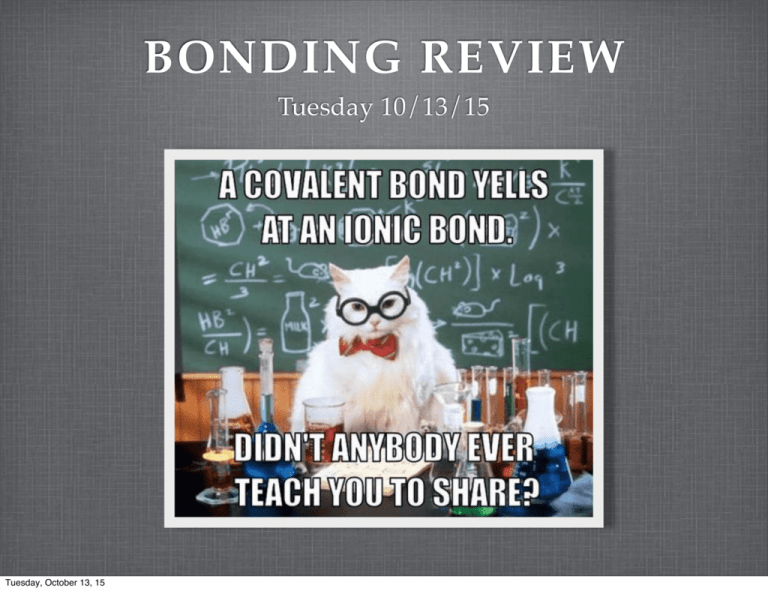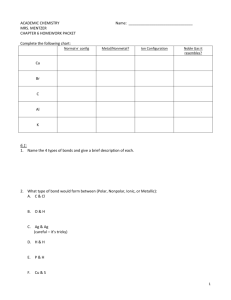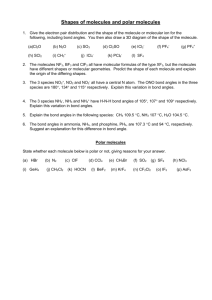10/13
advertisement

BONDING REVIEW Tuesday 10/13/15 Tuesday, October 13, 15 AGENDA Topic 4 Bonding Review Questions Tuesday, October 13, 15 TOMORROW The lab is a mess... All counters and sinks must be clean and empty! You will also complete a check-in/out list to make sure each item is in your drawer/cabinet. Label outside of drawer with your name. You and your partners will be responsible for this drawer. Tuesday, October 13, 15 THURSDAY You will get a little more time to review your packet of topic 4 practice questions (30 mins) We will have the laptops and I will give you ample time to work on your lab Please go by what is in the email for this week’s schedule not agenda, not the initial FB post from last week (I decided to change it due to losing 25 minutes Wednesday) Tuesday, October 13, 15 LEWIS STRUCTURE What is the correct Lewis structure for hypochlorous acid, a compound containing chlorine, hydrogen and oxygen? A. B. C. D. Tuesday, October 13, 15 LEWIS STRUCTURE What is the correct Lewis structure for hypochlorous acid, a compound containing chlorine, hydrogen and oxygen? A. B. C. D. Tuesday, October 13, 15 BOND ANGLES How do the bond angles in CH4, NH3 and H2O compare? A. CH4 = NH3 = H2O B. CH4 < NH3 < H2O C. NH3 < CH4 < H2O D. H2O < NH3 < CH4 Tuesday, October 13, 15 BOND ANGLES How do the bond angles in CH4, NH3 and H2O compare? A. CH4 = NH3 = H2O B. CH4 < NH3 < H2O C. NH3 < CH4 < H2O D. H2O < NH3 < CH4 Tuesday, October 13, 15 BOND ANGLES How do the bond angles in CH4, NH3 and H2O compare? Why is this the case?? A lone pair takes up more space (in VSEPR terms) than a bonded hydrogen. CH4 has only H bonded to the central atom, NH3 has one pair of lone electrons, and H2O has two lone pairs of electrons so the remaining hydrogens have to squeeze closer together. Tuesday, October 13, 15 BOND STRENGTH When C2H2, C2H4 and C2H6 are arranged in order of increasing carbon-carbon bond strength (weakest bond first), what is the correct order? A. C2H2, C2H4, C2H6 B. C2H2, C2H6, C2H4 C. C2H6, C2H4, C2H2 D. C2H6, C2H2, C2H4 Tuesday, October 13, 15 BOND STRENGTH When Ethene (C2H2), Etylene (C2H4) and C2H6 are arranged in order of increasing carbon-carbon bond strength (weakest bond first), what is the correct order? A. C2H2, C2H4, C2H6 B. C2H2, C2H6, C2H4 C. C2H6, C2H4, C2H2 D. C2H6, C2H2, C2H4 Tuesday, October 13, 15 BOND STRENGTH When Acetylene (C2H2), Ethylene (C2H4) and Ethane (C2H6) are arranged in order of increasing carboncarbon bond strength (weakest bond first), what is the correct order? Why is this the case?? A single bond is called a sigma bond and it consists of the end-to-end overlap of hybrid orbitals. Single bonds are the longest & weakest. A double bond is a sigma bond plus a pi bond. A pi bond is the side-to-side overlap of unhybridized p-orbitals. A double bond between the same two elements is shorter & stronger. A triple bond is a sigma bond plus two pi bonds. A triple bond between the same two elements is shortest & strongest. Tuesday, October 13, 15 PERIODIC TRENDS Which combination of the characteristics of element X, a metal, and element Y, a non metal, is most likely to lead to ionic bonding? Tuesday, October 13, 15 PERIODIC TRENDS Which combination of the characteristics of element X, a metal, and element Y, a non metal, is most likely to lead to ionic bonding? On right side of periodic table Tuesday, October 13, 15 On left side of periodic table PHYSICAL CHARACTERISTICS Explain why calcium has a higher melting point than potassium and why sodium oxide has a higher melting point than sulfur trioxide Tuesday, October 13, 15 PHYSICAL CHARACTERISTICS Calcium has a 2+ charge (twice that of potassium) and more delocalized electrons in the s orbital than compared to potassium - increasingly more negative Delocalization means the electron doesn’t exist to a single atom - think of it spread over the whole piece of metal. Another way to conceptualize delocalization is a “sea of electrons” ions surrounded by a sea of electrons. Tuesday, October 13, 15 PHYSICAL CHARACTERISTICS Sodium oxide (Na2O) is a network solid with a number of highly polar bonds which must be broken in order to melt. It has an ionic bond with a stronger electrostatic attraction between the Na+ ion and the O2- ion. Sulfur trioxide (SO3) is a molecule and has weaker van der Waals (dipole-dipole) attractions which are more easily broken than ionic bonds. However, the S=O bonds are stronger than the bonds within the Na2O molecules but it is the intermolecular bonds that are broken in order to make it melt, not the internal covalent bonds. Tuesday, October 13, 15 LEWIS STRUCTURES Ammonia, NH3, is a weak base. Draw the structure of ammonia and state the shape of the molecule and its bond angles. The conjugate acid of ammonia is the the ammonium ion, NH4+. Draw the Lewis Structure of the ammonium ion and deduce its shape and bond angles Tuesday, October 13, 15 LEWIS STRUCTURES Ammonia Trigonal Pyramidal Tuesday, October 13, 15 Ammonium ion Tetrahedral ISOTOPES Define the term isotopes A sample of silicon contains three isotopes: Calculate the relative atomic mass using this data Describe the structure & bonding of silicon dioxide and carbon dioxide. Tuesday, October 13, 15 RELATIVE ATOMIC MASS CALCULATIONS Ar = (massisotope 1)(abundanceisotope 1) + (massisotope 2)(abundanceisotope 2) 100 Tuesday, October 13, 15 STRUCTURE & BONDING Describe the structure & bonding of silicon dioxide and carbon dioxide. SiO2 - single covalent bonds that form a network solid arranged in tetrahedral geometries CO2 - double covalent bond which is a simple discrete molecule and does not form a network solid Tuesday, October 13, 15





